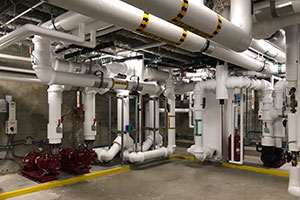 Providing our customers with services and support to achieve efficient building performance is a priority for District Energy. Did you know that our team can support your building projects and contractors by offering insights on mechanical design, equipment selection, and operational best practices so that your building can be heated and cooled to satisfy building occupants and operations?
Providing our customers with services and support to achieve efficient building performance is a priority for District Energy. Did you know that our team can support your building projects and contractors by offering insights on mechanical design, equipment selection, and operational best practices so that your building can be heated and cooled to satisfy building occupants and operations?
Mechanical equipment that does not match the needs and function of a building, or that is operating outside of design parameters, can increase energy use and decrease comfort of interior spaces. Let us help you avoid the pitfalls and keep the building performing beyond expectations.
Equipment Selection
Selecting the right building equipment is an important step in your project. Having oversized or undersized equipment can lead to premature failure, increased maintenance, functional challenges, and inefficiencies for the life of the equipment. Whether you are designing a system for new construction, renovating a building, or replacing equipment, there are several things to consider when making your equipment selection:
- Assess building programing and needs.
- Document all building equipment connected to the building’s heating and cooling systems.
- Identify design temperatures on all equipment.
- Set the basis of design for the installation and document the equipment to be installed.
- Following District Energy St. Paul connection standards is a critical component to getting the most of your heating and cooling connection. Operating outside of those standards, including delta T thresholds, can lead to wasted energy and additional costs for your operations and ours.
The District Energy team is available as a resource for your next project to review drawings, process and instrumentation diagrams, and submittals. Our team has extensive experience with district energy installations and the additional review can help you save time and money while reducing frustration.
Equipment Operation
Once you have the right equipment in place, operating the equipment as designed can lead to the best results in efficiency and comfort. Operating equipment outside of the manufacturer’s parameters can lead to failure, malfunction, and inefficiencies. There are many reasons that systems can be operating outside of the original design parameters, and you can follow these steps in an effort to reset your system:
- Locate your system’s “as-built” documentation or detailed drawings of installed equipment. If you don’t have the documentation, work with your system contractor to get them.
- If your mechanical equipment was commissioned, the documentation would include detailed operational parameters.
- Create operational documentation to support consistency across operations staff and to help onboard new staff.
- As new equipment is added to the system, update operational documentation.
- If parameters are changed to achieved a specific result, like heat to one zone or meeting required Delta T, remember to reset system settings so that the temporary fix does not become the “norm”
It is important to take the time to select the right equipment to meet the needs of your building and its occupants. Your investment of time can avoid additional costs, project setbacks, and operational frustrations. Once you have the right equipment in your building, operating your system within the design parameters will help you get the most out of your system. The team of experts at District Energy can help support your efforts every step of the way. We can offer insights on mechanical design, equipment selection, and operational best practices. Please contact our team at 651.297.8955 or by email info@districtenergy.com.